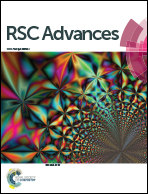Large-scale synthesis and characterization of magnetic poly(acrylic acid) nanogels via miniemulsion polymerization†
Abstract
This article provides a facile method for the large-scale preparation of magnetic poly(acrylic acid) (PAA) nanogels. Cross-linked polyacrylonitrile (PAN) nanoparticles were synthesized via a miniemulsion polymerization method using acrylonitrile (AN) and divinyl benzene (DVB) as the raw materials, and then PAA nanogels were obtained from the cross-linked PAN nanoparticles under basic conditions. The structure and morphologies of PAN nanoparticles, PAA nanogels, and magnetic PAA nanogels were characterized by Fourier-transformed infrared spectroscopy (FTIR), transmission electron microscopy (TEM), and dynamic light scattering equipment (DLS), respectively. The pH-responsive property of PAA nanogels was investigated by measuring their swelling–deswelling behavior under different pH buffer solutions. The results showed that the obtained PAN nanoparticles were of uniform spherical morphology with a wrinkled surface and had a narrow size distribution with an average size of 105 nm in diameter. PAA nanogels were regular spherical particles with an average particle size of 230 nm in diameter. The PAA nanogels demonstrated excellent pH-responsive properties in different pH buffer solutions. After the addition of γ-(trimethoxysilyl)propyl methacrylate (MPS) modified magnetic nanoparticles, magnetic PAA microgels were fabricated successfully.


 Please wait while we load your content...
Please wait while we load your content...